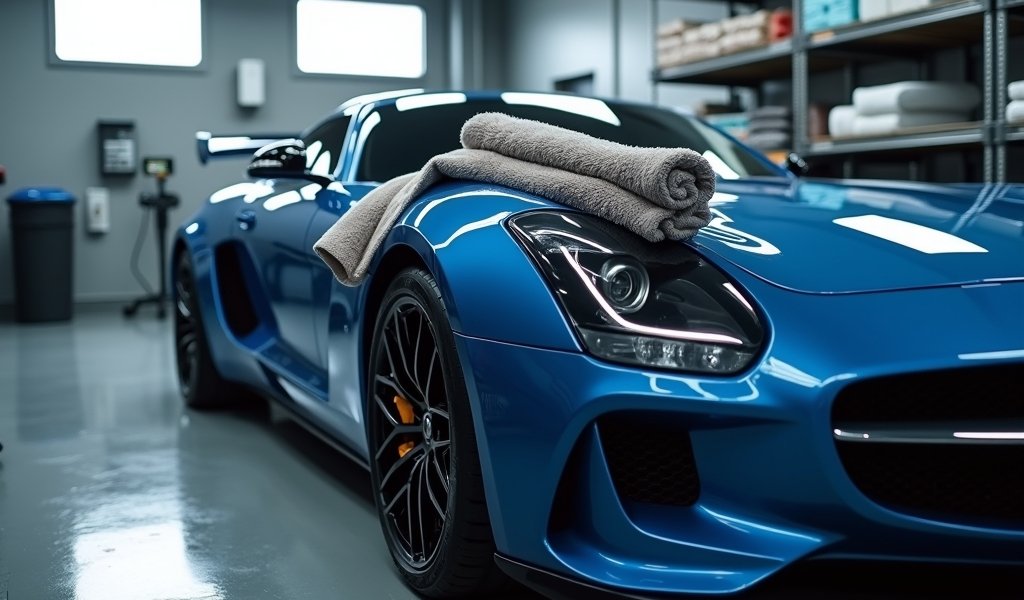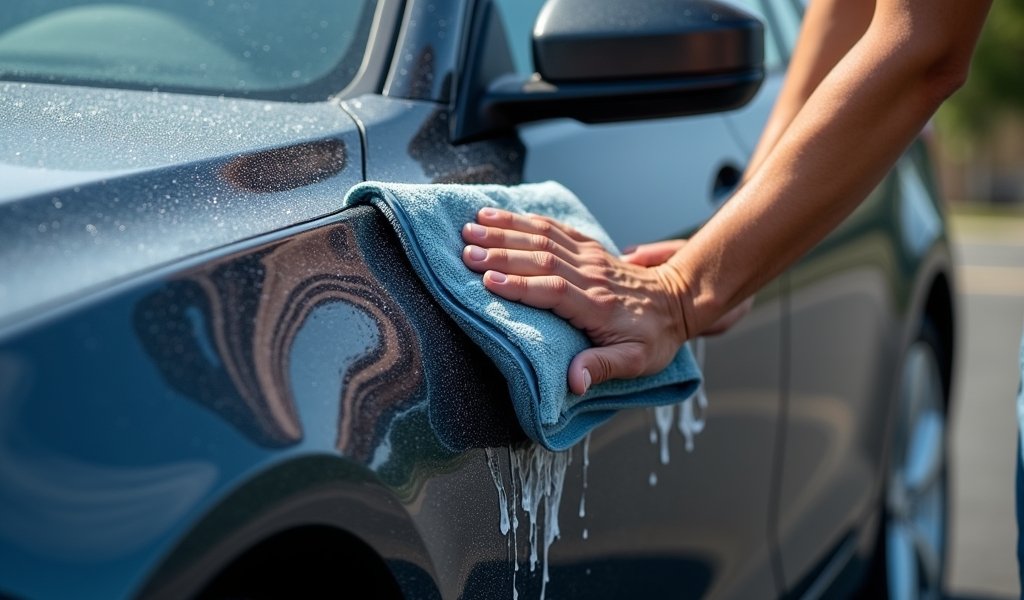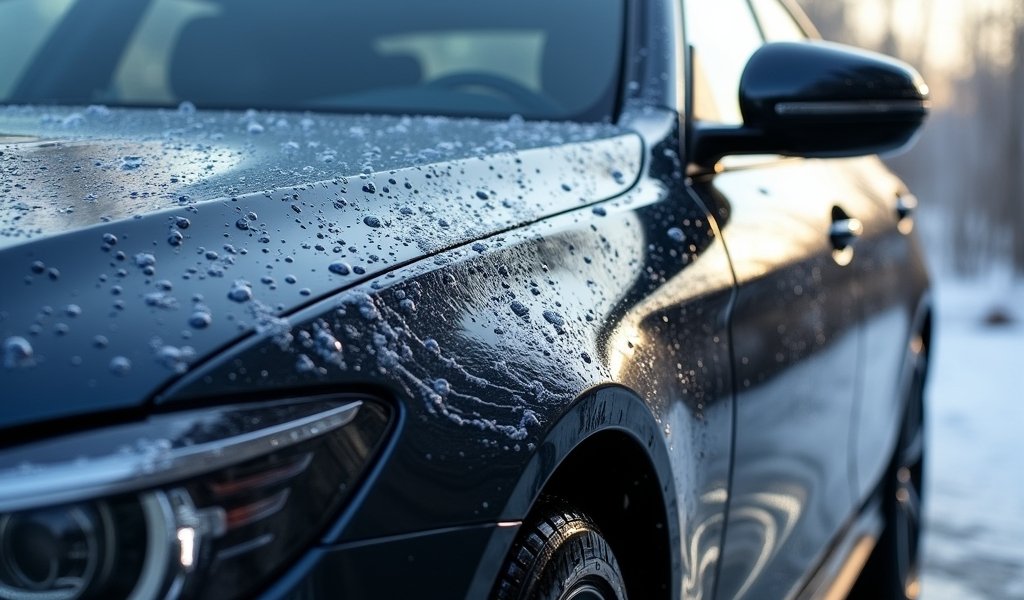Overview
This article explains why quality microfiber towels are essential for car cleaning, offering detailed guidance on selecting the right types based on GSM ratings (200-600+), specific tasks, and providing recommendations for various applications from drying to buffing. It emphasizes proper techniques, maintenance practices, and common mistakes to avoid when using microfiber towels, highlighting how these specialized cloths can protect automotive paint from microscratches when used correctly.
Table of Contents
- What Makes Microfiber Special for Car Cleaning
- Understanding GSM and Why It Matters
- Types of Microfiber Towels for Different Car Washing Tasks
- Top Microfiber Towel Picks for Car Enthusiasts
- Proper Microfiber Towel Techniques
- Care and Maintenance of Your Microfiber Arsenal
- Budget Considerations: Getting the Most Bang for Your Buck
- Common Mistakes to Avoid with Microfiber
- Conclusion
- Frequently Asked Questions
I’ve seen it happen a thousand times in my shop – a proud car owner rolls in, convinced their weekend washing routine is keeping their ride pristine, only to flinch when I point out the web of fine scratches covering their once-flawless paint. The culprit? Those old cotton towels or (heaven forbid) bath towels they’ve been using to dry their car. Finding the best microfiber towels for car wash sessions isn’t just some detailing nerd’s obsession – it’s your paint’s best defense against the microscopic damage that builds up wash after wash.
After 20+ years working with everything from daily drivers to show cars, I can tell you that no single tool has revolutionized car care quite like proper microfiber. Let me walk you through everything you need to know about these miracle cloths and how choosing the right ones can be the difference between maintaining your car’s finish and slowly destroying it one wipe at a time.
What Makes Microfiber Special for Car Cleaning
Microfiber isn’t just another cloth – it’s a technological marvel designed specifically to clean without scratching. These towels are made from ultra-fine synthetic fibers (typically polyester and polyamide/nylon) that are split into strands thinner than human hair. When woven together, they create a fabric with millions of tiny hooks and pockets that trap dirt, dust, and moisture instead of dragging them across your paint.
The science is actually pretty fascinating – each fiber is roughly 1/100th the diameter of a human hair, giving microfiber towels exponentially more cleaning surface area than cotton. This means they can pick up particles so tiny that cotton towels just push them around (and often right into your clear coat).
Just last month, I had a customer bring in his prized black Mustang that he’d been washing with his “lucky” old T-shirts for years. When I showed him under proper lighting what was happening to his paint, he nearly fell over. After switching him to a proper microfiber routine, the difference in his next detail was night and day.
Beyond their gentle touch, quality microfiber towels are absurdly absorbent – capable of holding up to seven times their weight in water. This means faster, more effective drying with less risk of water spots. They’re also washable and reusable, making them both environmentally and economically friendly compared to disposable options.
Understanding GSM and Why It Matters
When shopping for the best microfiber towels for car wash use, you’ll encounter the term “GSM” – which stands for Grams per Square Meter. Think of GSM as the “thread count” of microfiber, indicating the density of the material. It’s the single most important specification you need to understand when selecting towels for specific tasks.
Here’s a quick breakdown of GSM ranges and their ideal uses:
- 200-300 GSM: Lightweight towels perfect for glass cleaning, quick detailers, and interior surfaces
- 300-400 GSM: Medium-weight all-purpose towels good for general cleaning and wax/polish application
- 400-600 GSM: Plush, heavyweight towels ideal for final buffing, wax removal, and gentle paint contact
- 600+ GSM: Ultra-plush drying towels and detailing towels for the most delicate finishes
The GSM sweet spot often depends on your specific task. I keep towels from across this spectrum in my shop, each designated for particular jobs. My apprentice once mixed up the glass-cleaning microfibers with the wax-removal plush towels – the streaky windows and linty paint surface were immediate evidence that matching the right GSM to the right job matters!
Beyond GSM, pay attention to blend ratios. The gold standard for automotive use is typically an 80/20 polyester/polyamide blend, which offers the perfect balance of cleaning ability and absorbency. Some specialty towels might vary this ratio for specific tasks – higher polyamide content generally means better absorption but potentially less scrubbing power.

Types of Microfiber Towels for Different Car Washing Tasks
Not all microfiber towels are created equal, and using the right type for each job makes a massive difference in your results. After years of DIY car detailing, I’ve narrowed down the essential types every car owner should have in their arsenal:
Waffle Weave Towels
These textured towels have a distinctive waffle or honeycomb pattern that creates additional surface area for trapping water. They’re absolute champions for drying your vehicle quickly and streak-free. The texture acts like thousands of tiny water magnets, pulling moisture from the surface without requiring you to apply pressure.
I remember the first time I used a quality waffle-weave drying towel on a customer’s black sedan after years of using chamois – it literally cut my drying time in half while leaving zero water spots. Game changer.
Plush Pile Towels
These ultra-soft, deep-pile towels feel almost like velvet and are designed for the gentlest paint contact. They excel at final buffing, removing wax residue, and quick detailing sprays. The deep pile traps particles away from the paint surface, minimizing the risk of swirls.
The plush varieties (often 500+ GSM) are what I reach for during final inspection on show cars – they’re gentle enough to use on the most delicate clear coats without fear.
Short-Pile/Terry Weave Towels
These workhorses have a tighter, more traditional terry cloth-like weave that makes them excellent for general cleaning, applying products, and tackling interior surfaces. Their versatility makes them the foundation of any microfiber collection.
Glass-Specific Towels
Glass cleaning requires a specialized approach with low-lint, tightly woven microfiber. These typically have a much shorter pile and sometimes a ribbed texture that excels at streak-free window cleaning. According to Consumer Reports’ auto cleaning experts, dedicated glass towels are essential for truly spotless results.
I separate my glass towels with a vengeance after watching a customer use the same towel on their greasy dashboard and then immediately on their windshield – the resulting streaky mess took twice as long to fix than doing it right the first time.
Top Microfiber Towel Picks for Car Enthusiasts
After testing dozens of brands in professional detailing settings, here are my top recommendations for different car washing needs:
Best All-Around Microfiber Towels
- The Rag Company “Creature” Edgeless 420 GSM: These strike the perfect balance between plushness and utility. The edgeless design eliminates any possibility of the sewn edge scratching your paint.
- Chemical Guys Professional Grade Premium Microfiber Towels: Excellent quality at a reasonable price point, these 380 GSM towels handle everything from interior cleaning to light buffing.
Best Drying Towels
- Griots Garage PFM Terry Weave Drying Towel: This mammoth 25″ x 35″ waffle-weave towel can dry an entire vehicle with minimal wringing. I’ve seen one of these towels absorb enough water to dry a mid-sized SUV in one go.
- The Rag Company Dry Me A River Waffle Weave: The 70/30 blend and waffle pattern make this a water-absorbing monster that consistently prevents water spots.
Best Microfiber for Glass
- Rag Company Glass and Window Waffle Weave: The diamond-texture weave cuts through grime and leaves zero lint or streaks.
- Adam’s Glass Cleaning Towels: The 60/40 blend is specifically engineered for streak-free glass cleaning results.
Best Towels for Final Buffing/Polishing
- The Rag Company Eagle Edgeless 500 GSM: Ultra-soft with a deep pile that’s perfect for final buffing. The lack of edges means zero risk of creating swirls during those final passes.
- Meguiar’s Supreme Shine Microfiber: Plush 220 GSM towels that excel at removing product residue without marring.
These recommendations come from real-world testing in my shop, not just manufacturer claims. The difference between budget microfiber and professional-grade options becomes immediately apparent when you’re working on dark-colored vehicles where every imperfection shows.
Proper Microfiber Towel Techniques
Even the best microfiber towels for car wash sessions can damage paint if used incorrectly. Mastering these techniques will help you get maximum performance while minimizing the risk of marring your finish:
The Proper Fold
Don’t just wad up your microfiber! Fold it into quarters to create eight usable surfaces (four on each side). When one section becomes soiled, refold to expose a clean surface. This simple habit means one towel can effectively do the work of eight.
I had a regular client who couldn’t figure out why he was still getting swirls despite investing in premium microfiber. When I watched his technique, he was using one side of the towel for his entire car, essentially dragging accumulated dirt across his paint. Learning to fold properly immediately improved his results.
Directional Wiping
Always wipe in straight lines rather than circles when possible, especially on sensitive surfaces like piano-black trim or dark paint. This way, any minor imperfections will appear as straight lines rather than obvious circular swirls. When you need to make another pass, use a clean section of the towel.
Pressure Matters
Let the towel do the work – microfiber doesn’t need heavy pressure to be effective. In fact, excessive pressure increases the chances of grinding trapped particles into your clear coat. A light touch with quality microfiber is more effective than bearing down with force.
The Two-Towel Method
When drying, use one towel for the initial pass to remove most moisture, then follow with a second, completely dry towel for a perfect finish. This technique, recommended by professional detailing resources, prevents water spots and streaking, especially on dark vehicles.
Understanding proper car wash tips to avoid scratches goes hand-in-hand with mastering microfiber techniques – they’re two sides of the same coin when it comes to preserving your paint.

Care and Maintenance of Your Microfiber Arsenal
The way you care for your microfiber towels directly impacts their performance and longevity. Follow these guidelines to keep your towels in peak condition:
Washing Guidelines
- Wash microfiber separate from regular laundry to prevent lint contamination
- Use liquid detergent only – powder detergents can get trapped in the fibers
- Avoid fabric softeners completely – they coat the fibers and destroy absorbency
- Skip the bleach and fragranced products which can damage the synthetic fibers
- Use cool or warm water – never hot, which can damage the fibers’ structure
I once had a weekend warrior client complain that his expensive microfiber towels weren’t working anymore. Turns out his wife had helpfully washed them with the family laundry using fabric softener and high heat. Those $20 premium towels were effectively ruined – a costly lesson in proper microfiber care!
Drying Done Right
Always dry microfiber on low heat or air dry. High heat can melt the synthetic fibers and create rough spots that can scratch paint. Never use dryer sheets with microfiber for the same reasons you avoid fabric softener.
Smart Storage Solutions
Store clean, completely dry towels in sealed containers or ziplock bags to prevent dust contamination. I use a color-coded bin system in my shop: blue bins for glass towels, red for drying towels, black for wheels/exhaust, and white for paint-safe buffing towels. This prevents cross-contamination and makes grabbing the right towel effortless.
Towel Retirement Plan
Even well-maintained microfiber towels eventually wear out. Look for matting, reduced absorbency, or lingering stains as signs it’s time to demote or replace a towel. When a premium buffing towel starts showing wear, I don’t discard it – I demote it to less critical duties like interior cleaning before eventually retiring it to garage duty.
Budget Considerations: Getting the Most Bang for Your Buck
Building a proper microfiber collection doesn’t have to break the bank if you shop smart. Here’s how to balance quality with cost:
Tiered Approach to Towel Investment
Invest the most in towels that directly contact your paint for final buffing and drying. These are where quality differences are most noticeable and where inferior products can cause the most damage. You can save a bit on interior, glass, and wheel towels without as much risk.
Last year, I had a client who balked at spending $30 on a premium drying towel for his new $85,000 Audi. I asked him if he’d save $30 on brake pads for the same car. Perspective matters when protecting your investment!
Budget-Friendly Options That Perform
Kirkland Signature Ultra Plush Microfiber Towels from Costco offer surprising quality for their price point. They’re not quite professional grade, but they’re perfectly acceptable for regular maintenance washing. Amazon Basics also offers decent entry-level options for non-critical applications.
Bulk Buying Wisdom
Buying towels in kits or bulk packs usually offers significant savings, but be careful not to sacrifice quality just to get more towels. Ten excellent towels will serve you better than 50 mediocre ones that risk scratching your paint. Warehouse clubs often offer good values on larger packs of decent quality towels.
If you’re serious about detailing your car like a pro, consider starting with a smaller collection of truly excellent towels and expanding gradually rather than compromising on quality from the start.
Common Mistakes to Avoid with Microfiber
Even experienced detailers sometimes fall into these microfiber traps. Avoid these pitfalls to get the most from your towels:
Cross-Contamination Catastrophes
Never use the same towel on different surfaces without washing in between. The towel that cleaned your wheels should never touch your paint. I color-code my towels religiously after witnessing a well-meaning client use the same towel on their exhaust tips and then their glossy black trim – instant microscratches that took hours of polishing to fix.
The Dropped Towel Dilemma
If you drop a microfiber towel on the ground, consider it contaminated. Even if it looks clean, it’s likely picked up invisible particles that can scratch your paint. Set it aside for washing rather than risking your finish. I keep a small “quarantine” bin in my detail area specifically for compromised towels.
Over-Saturation Situation
Microfiber works best when slightly damp for cleaning, not soaking wet. Over-saturated towels can’t properly trap particles and lose much of their effectiveness. Wring them thoroughly before use (except when using as a drying towel, where maximum absorbency is the goal).
The One-Side Wonder
Using only one side of a towel is literally leaving half its value unused. Proper folding and flipping techniques ensure you get maximum mileage from each towel. I’ve watched clients use a towel once and toss it in the “dirty” pile when it had seven perfectly clean surfaces left to use!
Conclusion
The humble microfiber towel might seem like a minor detail in your car care arsenal, but it’s actually one of your most powerful allies in maintaining that showroom finish. Investing in the best microfiber towels for car wash sessions – and learning how to use and maintain them properly – will save you money in the long run by preventing damage that requires expensive correction.
Remember: not all microfiber is created equal. Understanding GSM ratings, construction types, and appropriate uses for different towels will transform your washing and detailing results. When paired with proper technique and care, quality microfiber becomes the foundation of paint-safe maintenance that keeps your vehicle looking its best year after year.
Whether you’re caring for a daily driver or a show car, the principles remain the same: use the right tool for the right job, maintain your equipment properly, and follow best practices consistently. Your car’s finish will thank you with years of swirl-free, glossy perfection – and isn’t that what we’re all after?
Frequently Asked Questions
How many microfiber towels do I need for a basic car wash?
For a basic wash, you’ll need at minimum 5-6 towels: 2 for washing, 1-2 dedicated drying towels, 1-2 for glass, and 1 for wheels/exhaust.
Can I use the same microfiber towels for interior and exterior cleaning?
No, always separate your towels by task. Interior towels can pick up abrasive particles that may scratch exterior paint surfaces.
How often should I replace my microfiber towels?
Quality microfiber towels should last 20-50 washes before needing replacement. Replace them sooner if you notice reduced absorbency, matting, or lingering stains.
Is it better to have a few expensive microfiber towels or many cheaper ones?
It’s better to have a smaller collection of high-quality towels than numerous poor-quality ones. Premium towels clean better, last longer, and are less likely to damage your paint.
Can I use microfiber towels with all car cleaning products?
Yes, but avoid products containing strong solvents or bleach which can damage the fibers. Rinse towels thoroughly after use with wax/polish to prevent product buildup.

